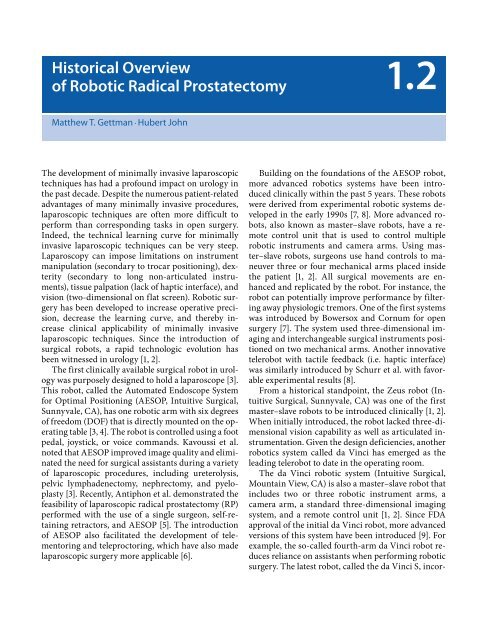7 - E-Lib FK UWKS
7 - E-Lib FK UWKS
7 - E-Lib FK UWKS
You also want an ePaper? Increase the reach of your titles
YUMPU automatically turns print PDFs into web optimized ePapers that Google loves.
Historical Overview<br />
of Robotic Radical Prostatectomy<br />
Matthew T. Gettman ∙ Hubert John<br />
The development of minimally invasive laparoscopic<br />
techniques has had a profound impact on urology in<br />
the past decade. Despite the numerous patient-related<br />
advantages of many minimally invasive procedures,<br />
laparoscopic techniques are often more difficult to<br />
perform than corresponding tasks in open surgery.<br />
Indeed, the technical learning curve for minimally<br />
invasive laparoscopic techniques can be very steep.<br />
Laparoscopy can impose limitations on instrument<br />
manipulation (secondary to trocar positioning), dexterity<br />
(secondary to long non-articulated instruments),<br />
tissue palpation (lack of haptic interface), and<br />
vision (two-dimensional on flat screen). Robotic surgery<br />
has been developed to increase operative precision,<br />
decrease the learning curve, and thereby increase<br />
clinical applicability of minimally invasive<br />
laparoscopic techniques. Since the introduction of<br />
surgical robots, a rapid technologic evolution has<br />
been witnessed in urology [1, 2].<br />
The first clinically available surgical robot in urology<br />
was purposely designed to hold a laparoscope [3].<br />
This robot, called the Automated Endoscope System<br />
for Optimal Positioning (AESOP, Intuitive Surgical,<br />
Sunnyvale, CA), has one robotic arm with six degrees<br />
of freedom (DOF) that is directly mounted on the operating<br />
table [3, 4]. The robot is controlled using a foot<br />
pedal, joystick, or voice commands. Kavoussi et al.<br />
noted that AESOP improved image quality and eliminated<br />
the need for surgical assistants during a variety<br />
of laparoscopic procedures, including ureterolysis,<br />
pelvic lymphadenectomy, nephrectomy, and pyeloplasty<br />
[3]. Recently, Antiphon et al. demonstrated the<br />
feasibility of laparoscopic radical prostatectomy (RP)<br />
performed with the use of a single surgeon, self-retaining<br />
retractors, and AESOP [5]. The introduction<br />
of AESOP also facilitated the development of telementoring<br />
and teleproctoring, which have also made<br />
laparoscopic surgery more applicable [6].<br />
1.2<br />
Building on the foundations of the AESOP robot,<br />
more advanced robotics systems have been introduced<br />
clinically within the past 5 years. These robots<br />
were derived from experimental robotic systems developed<br />
in the early 1990s [7, 8]. More advanced robots,<br />
also known as master–slave robots, have a remote<br />
control unit that is used to control multiple<br />
robotic instruments and camera arms. Using master–slave<br />
robots, surgeons use hand controls to maneuver<br />
three or four mechanical arms placed inside<br />
the patient [1, 2]. All surgical movements are enhanced<br />
and replicated by the robot. For instance, the<br />
robot can potentially improve performance by filtering<br />
away physiologic tremors. One of the first systems<br />
was introduced by Bowersox and Cornum for open<br />
surgery [7]. The system used three-dimensional imaging<br />
and interchangeable surgical instruments positioned<br />
on two mechanical arms. Another innovative<br />
telerobot with tactile feedback (i.e. haptic interface)<br />
was similarly introduced by Schurr et al. with favorable<br />
experimental results [8].<br />
From a historical standpoint, the Zeus robot (Intuitive<br />
Surgical, Sunnyvale, CA) was one of the first<br />
master–slave robots to be introduced clinically [1, 2].<br />
When initially introduced, the robot lacked three-dimensional<br />
vision capability as well as articulated instrumentation.<br />
Given the design deficiencies, another<br />
robotics system called da Vinci has emerged as the<br />
leading telerobot to date in the operating room.<br />
The da Vinci robotic system (Intuitive Surgical,<br />
Mountain View, CA) is also a master–slave robot that<br />
includes two or three robotic instrument arms, a<br />
camera arm, a standard three-dimensional imaging<br />
system, and a remote control unit [1, 2]. Since FDA<br />
approval of the initial da Vinci robot, more advanced<br />
versions of this system have been introduced [9]. For<br />
example, the so-called fourth-arm da Vinci robot reduces<br />
reliance on assistants when performing robotic<br />
surgery. The latest robot, called the da Vinci S, incor-











![SISTEM SENSORY [Compatibility Mode].pdf](https://img.yumpu.com/20667975/1/190x245/sistem-sensory-compatibility-modepdf.jpg?quality=85)





